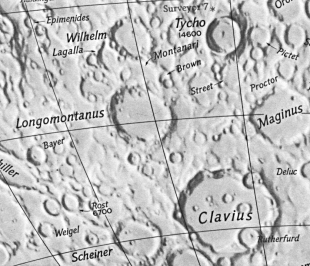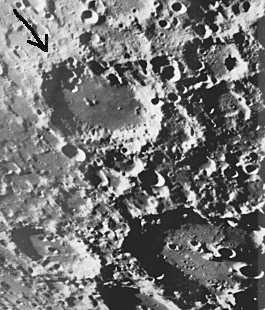

Initial Report of Observations:
For archive searching on this report, you need to know that I had originally misidentified the crater where this ray occurred as Walter. It was only after an exchange of a couple messages with the list that I was able to determine that a) Walter has a sunset ray, not one that would occur 10 days into a lunation, b) Walter wasn't on the terminator on that date in any case, and c) the only prominent crater in that area of the Moon that was on the terminator at the right time was Longomontanus. I was also misspelling Longomontanus -- as Longmontanus -- consistently after finding the correct crater. I have the original report (with incorrect identification) in my local e-mail files; observation was between 18:30 and 22:30 PDT, April 24 1999 (0130 to 0530 1999-04-25 UT). There's also an image of Longomontanus, taken about 23:30 PDT, about an hour after I turned in that night, showing a broader ray than what I saw: http://www.fortunecity.com/victorian/canterbury/222/ray.htm - Don Qualls At about 12:30 p.m. EDT (04:30 UT 2000/6/10) we returned to the setting moon just before it was "occulted" by a neighboring house. I happened to notice what turned out to be a fairly recently discovered lunar ray in the crater Longmontanus. This crater has a prominent central peak, part of which was in direct sunlight. The ray did not illuminate very much of the crater floor. - Dave Mitsky The crater ray that Donald has described was very likely in the crater LONGOMONTANUS. I was video imaging the moon Saturday night / Sunday morning and captured an image of LONGOMONTANUS showing a v-shape, ray-like light crossing the smooth crater floor. There is a small group of peaks near the center of LONGOMONTANUS and they did indeed cast a shadow across the floor almost to the western wall of the crater. I have never seen the Walter's ray, but I have little doubt that it would be similar in appearance to the light on the floor of LONGOMONTANUS. - Jim Ferreira
By running predictions using site coordinates, date and time of the event, it was determined that the event could be seen when the sun was 1.354 rising, with an average colongitude of 23.785 degrees. This data was used to compute the predictions, found on the prediction page.
Starting Date = 1999 / 4 / 25 U.T.
Site Longitude = 122.00 Latitude = 0.78 Elevation = 173 meters
Feature = LONGOMONTANUS
Longitude = -21°42' Latitude = -49°30'
Reproducing Lighting For: 1999 / 4 / 25 at 3 : 30 UT
Desired Solar altitude = 1.354° (Rising), Azimuth = 90.725°
Average Co-longitude = 23.785
In the time column, D=daylight, T=twilight
---- Moon's ----
Topocentric -- Earth's -- ------- Sun's -------
UT Date Time Alt° Semi-diam" long° lat° colong° lat° azim°
1999/ 4/25 3:30 73.90 932.97 6.44 -1.60 22.03 -1.50 90.73
1999/ 6/23 3:13t 77.43 904.12 4.28 -6.44 22.51 -1.09 90.09
1999/ 8/21 4:39 64.39 901.70 -0.87 -5.37 24.25 0.40 87.80
1999/10/19 7:41 25.08 920.95 -6.27 0.57 25.55 1.51 86.10
2000/ 1/15 23:29d 32.02 975.55 -5.80 6.74 24.11 0.28 87.98
2000/ 3/15 0:15d 33.67 979.28 0.42 1.72 22.36 -1.21 90.28
Longomontanus, -248, -761 - A grand ring, on eof the largest of al the lunar walled plains, 90 miles in diameter with very complex walls, abounding in ridges and rocky spurs, with a crater chain on the east and on the inner south-west slope. On the south are old partial rings, also some on the north, with numerous craters.On the dusky interior is a group of hills near the centre, consisting of three principal and several lesser masses. To the south are crater pits, and there is a small ring touching the inner western slope. On the crest at this point is a crater. A mass of craters lies on the north-eastern portion of the interior, also some low hill and mounds. All around are many craters. To the west of the centre is an isolated cratercone, with a very minute hillock just to the east of it. Wilkins found a delicate cleft, 24 December 1944, a little to the west of the central mountain group.
The large inclosure K, on the inner north, has two craterlets on its west rim and a fine craterlet chain farther west, from which it runs down the broad slope and on to the floor on the western side of an intrusive mass, evidently the remains of an old ring. THe inner south-west slope is distinguished by dykes of rock which stand out very prominently at times, while the relic of an old ring lies on the inner south.
To the north are the craters B and C, with numerous ridges and smaller craters. A similar confused mass of ridges and craters lies on the east; on the south the craters increase in size and numbers up to the wall of Scheiner - Wilkins & Moore, The Moon, Faber & Faber, 1955

